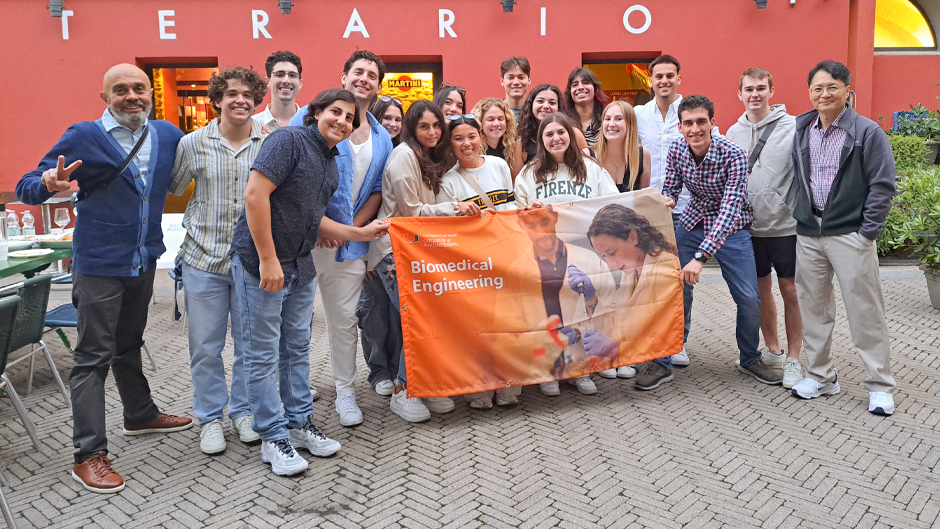It’s a place where Leonardo da Vinci and Galileo Galilei flourished as children. Their contributions later formed the basis for modern medicine, math, science, and engineering.
And coincidentally, Florence, Italy, is also the place where biomedical engineering lecturer and stem cell researcher Gianluca D’Ippolito was raised. This summer, D’Ippolito led the first University of Miami College of Engineering Study Abroad program and shared the sights and history of his Italian hometown with 17 students and his co-teacher, biomedical engineering associate professor Charles Huang.
“Florence is the cradle of the Renaissance,” D’Ippolito said. “It’s a place where students can learn culture by going to its museums and visiting villas to see the incredible architecture. And it’s also close to northern Italy, which is one of Europe’s top industrial centers—all of that is important for engineers.”
Junior Sofia Franciosa was one of the students who spent six weeks in Florence as part of the program. She said that she entered college wanting to study abroad, but struggled to fit it into the rigorous class schedule required for aspiring biomedical engineers.
Yet, because this program was offered during the summer, it allowed her to study abroad while enrolled in “Biomaterials,” a class required for bioengineering majors. She said the experience was priceless.
“It lined up perfectly because I could take a class that helps with my major, while also going somewhere I had wanted to visit,” she said, adding that the instructors helped confirm her decision. “I’d had D’Ippolito before, and I was excited to take biomaterials with him because he is always enthusiastic about the material. And I knew he was passionate about going to Italy, so the class was a perfect mix of everything.”
Organized with Cultural Experiences Abroad, an educational services company, and the University’s Office of Study Abroad, the majority of students who attended this inaugural program were biomedical engineering majors, with one student studying chemistry and another focusing on civil engineering. The program is open to all University students who are interested in taking the class.
As part of the course, students visited and toured biomedical labs at the 900-year-old University of Bologna and the University of Florence. They also visited Imaginalis, a nearby medical device company that is focused on developing new 2D- and 3D-imaging platforms. In one of the University of Bologna labs, junior Emma Craig was able to see a rare engineering feat they had just learned about in class called electrospinning, which is when a filament is created using liquid polymer and an electric charge. The filament is often used to secure skin grafts, she noted.
“I got to speak with professors utilizing bioprinting solutions. So, we got that face-to-face experience with people doing the things that I want to do someday,” said Craig, a biomedical engineering major. “This helped to open our eyes about creating solutions to help people heal across the world.”
Some weekends, D’Ippolito showed the students the highlights of the Tuscany region around Florence. They visited the Tower of Pisa near the coast and the centuries-old Medici Villas, owned by the wealthy and powerful family that chose to integrate the beautiful countryside with their homes and elaborate gardens—now designated a UNESCO World Heritage Site. They also went to the Lamborghini factory and Ferrari museum, along with the da Vinci and Galileo museums. One evening, the students even made their own biomaterial—pasta.
Craig said that D’Ippolito’s knowledge of Tuscany helped them appreciate the area even more. And Franciosa agreed. “It’s one of the best experiences I’ve had in college,” she said. “It was such a good time and connected me with people in my [BME] program. I’d recommend it to anyone.”
College of Engineering Dean Pratim Biswas said that he hopes even more of his faculty members will lead study abroad programs. Fabrice Manns, chair of the Department of Biomedical Engineering, said he was pleased with the program’s success and is glad that D’Ippolito and Huang plan to return to Florence next summer.
In addition to the Italy experience, D’Ippolito plans to offer a second faculty-led program in Kyoto, Japan, with Francesco Travascio, an associate professor of mechanical and aerospace engineering, where they plan to teach cellular engineering and systems dynamics. In this four-week program, D’Ippolito aims to take students to the labs at the University of Kyoto, including the Center for iPS cell Research and Application, known for its stem cell work, as well as the Mitsubishi factory.
“This program was a really transformational experience for these students, so we are hoping this is a way to give more engineering students the opportunity to do study abroad in a more structured way,” said Manns. “This program is opening more opportunities for engineering students to get that experience overseas.”
To learn more about Study Abroad experiences this spring and summer, attend a Study Abroad 101 session, or make an appointment with an advisor.

